Abstract
The present, study was conducted to determine the level of malondialdehyde (MDA) as an index of free radial induced lipid peroxidation and antioxidant vitamins-vitamins A, vitamin C and vitamin E in 75 confirmed cases of urolithiasis. Significantly high level of MDA (p<0.001) with significantly low levels of vitamin E (p<0.001) and vitamin A (p<0.001) with no significant decrease in vitamin C (p>0.05) were observed in the plasma of urolithiasis cases as compared to normal controls. In conclusion, it appears that a role of lipid peroxidation and oxidative function exists in the pathogenesis of urolithiasis. But, the exact mechanism how this occurs remains to be elucidated.
Similar content being viewed by others
References
Gill WB, Ruggiero KJ, Straus FH. Crystallization studies in the endothelial—lined living test tube (the catheterized female rat bladder). I. Calcium oxalate crystal adhesion to the chemically injured rat bladder. Invest Urol 1979; 17: 257–61.
Trump BF, Berzesck IK, Laiho KV, Osorino AR, Merger WJ, Smith MV. The role of calcium in cell injury. Scann Electron Micros 1980; 2: 437–62.
Buege JA, Aust AD. Microsomal lipid peroxidation. In Methods Enzymeol Estbrook RW, Pullman ME. New York: Acad Press, 1987: 302–10.
Natelson S. Vitamin A and Carotene, In: Technics of Clinical Chemistry, 3rd Edition, Charles C Thomas, Illinios: USA. 1971: 751–55.
Baker H, Frank O. Vitamin E. In Clinical vitaminology methods and interpretation, Interscience publishers, New York, 1968: 169–76.
Natelson S. Ascorbic acid. In Technics of Clinical Chemistry, 3rd Edition, Charles C Thomas, Illinios USA. 1971: 162–65.
Pak CYC. Citrate and Renal Calcull. Min Electrol Metabol 1987; 13: 257–66.
Hgi S, Berkant MK, Sevil G, Osman A, Nazam U, Yasemin D, Ataman G. Lipid peroxidation and antioxidant enzyme levels of intestinal, renal and muscle, tissues after a 60 minutes exercise in drowned mice. Ind J Physiol Pharmacol 2000; 44: 499–506.
Liao LL, Richardson KE. The metabolism of oxalate precursor in isolated perfused Rat livers. Arch Biochem Biophys 1972; 153: 438–48.
Thamilselvan S, Menon S. Vitamin E therapy prevents hyperoxaluria—induced calcium oxalate crystal deposition in kidney by improving renal tissue antioxidant status. BJU Int 2005; 96: 117–26.
Finlayson B. Physiochemical aspects of Urolithiasis. Kidney Intl 1978; 13: 344–60.
Golovanov SA, Lanenko EK, Ozeuanov NK, Drozhzheva VV, Beishliev DA, Konkova TA. Lipid peroxidation and antioxidant system of patients with urolithiasis after extracorporal lithotripsy. Urol Nephrol 1998; 2: 14–16.
Huang HS, Chen CF, Chen J. Lipid peroxidation and its correlations with urinary levels of oxalate, citric acid and osteopontin in patients with renal calcium oxalate stones. J Urol 2003; 62: 1123–8.
Singh PP, Barhatiya MK. Peroxidative stress and antioxidant status in relation to age in normal population and renal stone formers. Ind J Nephrol 2002; 12: 9–15.
Sakly R, Fekih M, Ben AA, Wajjar MF, Mbazaa M. Possible role of vitamin A and E deficiency in human idiopathic lithiasis. Ann Urol 2003; 37: 217–19.
Santosh KM, Selvan R. Supplementation of vitamin E and selenium prevents hyperoxaluria in experimental urolithic rate. J Nutr Biochem 2003; 14: 306–13.
Chalmeu AH, Cowley DM, Brown JM. A possible etiological role of ascorbate in calculi formation. Clin Chem 1986; 32: 333–6.
Massey LK, Liebman M, Kynast GS. Ascrobate increases human oxaluria and kidney stone risk. J Nutr 2005; 135: 1673–7.
Jakeslko I, Porowski I, Zoch ZW, Wasilewska AM, Hackiewicz L. Assessment of oxalate concentration in serum and urine of children with renal stones. Wiad Lek 2005; 58: 20–24.
Author information
Authors and Affiliations
Corresponding author
Rights and permissions
About this article
Cite this article
Kato, J., Ruram, A.A., Singh, S.S. et al. Lipid peroxidation and antioxidant vitamins in urolithasis. Indian J Clin Biochem 22, 128–130 (2007). https://doi.org/10.1007/BF02912895
Issue Date:
DOI: https://doi.org/10.1007/BF02912895




